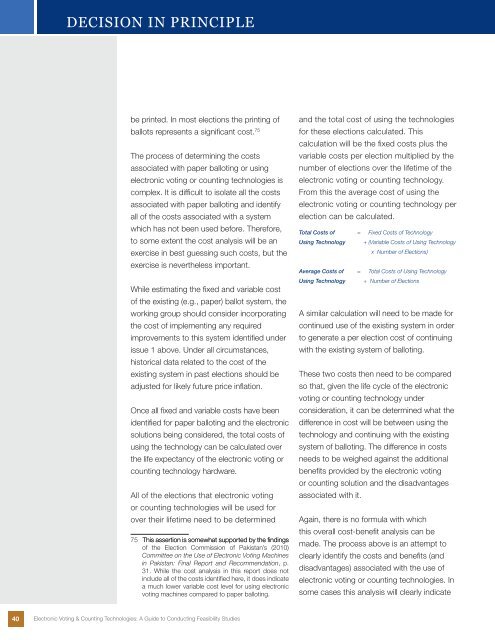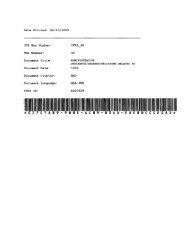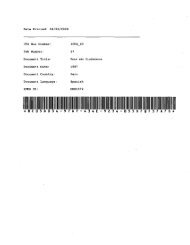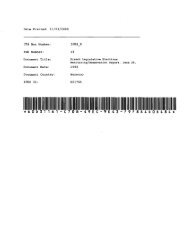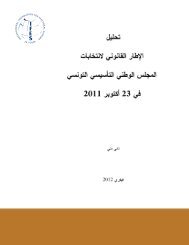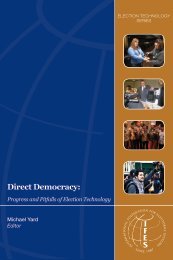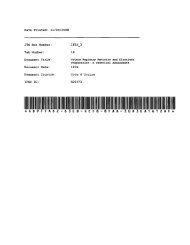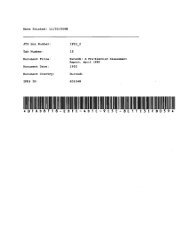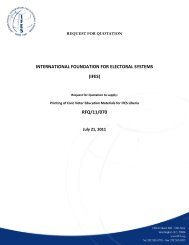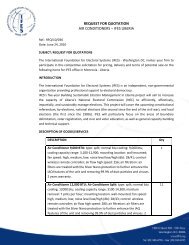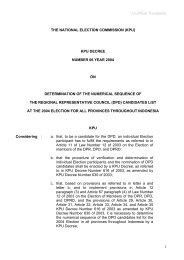Electronic Voting & Counting Technologies - IFES
Electronic Voting & Counting Technologies - IFES
Electronic Voting & Counting Technologies - IFES
- No tags were found...
Create successful ePaper yourself
Turn your PDF publications into a flip-book with our unique Google optimized e-Paper software.
INTERNATIONAL DECISION PRINCIPLEELECTORAL STANDARDSbe printed. In most elections the printing ofballots represents a significant cost. 75The process of determining the costsassociated with paper balloting or usingelectronic voting or counting technologies iscomplex. It is difficult to isolate all the costsassociated with paper balloting and identifyall of the costs associated with a systemwhich has not been used before. Therefore,to some extent the cost analysis will be anexercise in best guessing such costs, but theexercise is nevertheless important.While estimating the fixed and variable costof the existing (e.g., paper) ballot system, theworking group should consider incorporatingthe cost of implementing any requiredimprovements to this system identified underissue 1 above. Under all circumstances,historical data related to the cost of theexisting system in past elections should beadjusted for likely future price inflation.Once all fixed and variable costs have beenidentified for paper balloting and the electronicsolutions being considered, the total costs ofusing the technology can be calculated overthe life expectancy of the electronic voting orcounting technology hardware.All of the elections that electronic votingor counting technologies will be used forover their lifetime need to be determined75 This assertion is somewhat supported by the findingsof the Election Commission of Pakistan’s (2010)Committee on the Use of <strong>Electronic</strong> <strong>Voting</strong> Machinesin Pakistan: Final Report and Recommendation, p.31. While the cost analysis in this report does notinclude all of the costs identified here, it does indicatea much lower variable cost level for using electronicvoting machines compared to paper balloting.and the total cost of using the technologiesfor these elections calculated. Thiscalculation will be the fixed costs plus thevariable costs per election multiplied by thenumber of elections over the lifetime of theelectronic voting or counting technology.From this the average cost of using theelectronic voting or counting technology perelection can be calculated.Total Costs of = Fixed Costs of TechnologyUsing Technology + (Variable Costs of Using Technologyx Number of Elections)Average Costs of = Total Costs of Using TechnologyUsing Technology ÷ Number of ElectionsA similar calculation will need to be made forcontinued use of the existing system in orderto generate a per election cost of continuingwith the existing system of balloting.These two costs then need to be comparedso that, given the life cycle of the electronicvoting or counting technology underconsideration, it can be determined what thedifference in cost will be between using thetechnology and continuing with the existingsystem of balloting. The difference in costsneeds to be weighed against the additionalbenefits provided by the electronic votingor counting solution and the disadvantagesassociated with it.Again, there is no formula with whichthis overall cost-benefit analysis can bemade. The process above is an attempt toclearly identify the costs and benefits (anddisadvantages) associated with the use ofelectronic voting or counting technologies. Insome cases this analysis will clearly indicate40<strong>Electronic</strong> <strong>Voting</strong> & <strong>Counting</strong> <strong>Technologies</strong>: A Guide to Conducting Feasibility Studies


